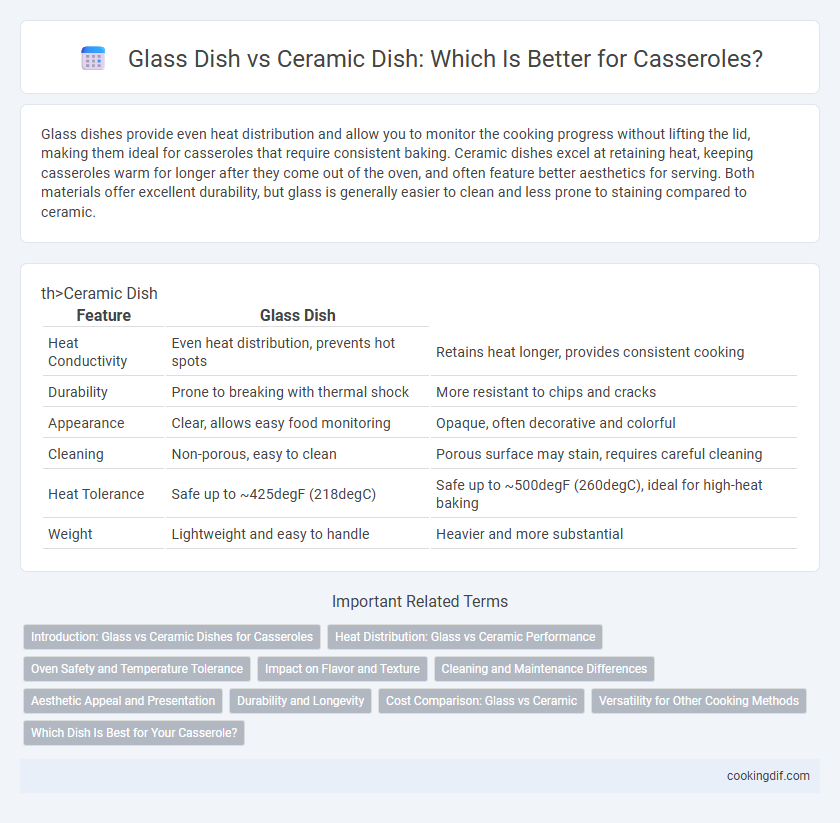Glass dishes provide even heat distribution and allow you to monitor the cooking progress without lifting the lid, making them ideal for casseroles that require consistent baking. Ceramic dishes excel at retaining heat, keeping casseroles warm for longer after they come out of the oven, and often feature better aesthetics for serving. Both materials offer excellent durability, but glass is generally easier to clean and less prone to staining compared to ceramic.
Table of Comparison
| Feature | Glass Dish | th>Ceramic Dish|
|---|---|---|
| Heat Conductivity | Even heat distribution, prevents hot spots | Retains heat longer, provides consistent cooking |
| Durability | Prone to breaking with thermal shock | More resistant to chips and cracks |
| Appearance | Clear, allows easy food monitoring | Opaque, often decorative and colorful |
| Cleaning | Non-porous, easy to clean | Porous surface may stain, requires careful cleaning |
| Heat Tolerance | Safe up to ~425degF (218degC) | Safe up to ~500degF (260degC), ideal for high-heat baking |
| Weight | Lightweight and easy to handle | Heavier and more substantial |
Introduction: Glass vs Ceramic Dishes for Casseroles
Glass casserole dishes offer excellent heat distribution and allow cooks to monitor the browning and doneness of their dishes, making them ideal for recipes that benefit from precise cooking. Ceramic dishes provide superior heat retention, keeping casseroles warm for longer periods and often feature attractive designs suitable for serving directly from oven to table. Both materials withstand high oven temperatures, but glass cooks food more evenly, while ceramic adds an aesthetic appeal and durable resistance to thermal shock.
Heat Distribution: Glass vs Ceramic Performance
Glass casserole dishes provide even heat distribution, allowing food to cook uniformly with minimal hot spots, making them ideal for baked casseroles requiring consistent temperature. Ceramic dishes offer excellent heat retention, distributing heat more slowly but maintaining warmth longer after removal from the oven, which enhances serving temperature and flavor melding. While glass heats up quickly and cools faster, ceramic's dense composition ensures steady heat conduction, influencing cooking times and texture outcomes in casserole recipes.
Oven Safety and Temperature Tolerance
Glass casserole dishes offer excellent oven safety with temperature tolerance typically up to 446degF (230degC), ensuring even heat distribution and resistance to thermal shock when properly preheated. Ceramic dishes can withstand higher temperatures, often up to 500degF (260degC), and provide superior heat retention, ideal for slow-cooked casseroles, but require gradual heating to prevent cracking. Both materials are safe for oven use, but glass performs best for quick temperature changes, while ceramic excels in maintaining consistent cooking heat.
Impact on Flavor and Texture
Glass casserole dishes provide even heat distribution that promotes thorough cooking and enhances caramelization, resulting in a slightly crispier texture and intensified flavors. Ceramic dishes retain heat longer and offer gentle, consistent warmth, which helps maintain moisture and produces a tender, evenly cooked casserole with subtle flavor blending. Choosing between glass and ceramic impacts the casserole's texture and flavor depth, with glass favoring crispness and caramelization while ceramic emphasizes tenderness and moisture retention.
Cleaning and Maintenance Differences
Glass casserole dishes are non-porous, making them resistant to staining and easier to clean with minimal absorption of odors or flavors. Ceramic dishes, while aesthetically pleasing and excellent for heat retention, can be more prone to staining and require gentle cleaning to avoid scratching or damaging the glaze. Both materials are generally dishwasher safe, but glass dishes typically demand less maintenance to retain their clarity and smooth surface over time.
Aesthetic Appeal and Presentation
Glass casserole dishes offer a sleek, transparent aesthetic that showcases layered ingredients and vibrant colors, enhancing the visual appeal of the dish. Ceramic casserole dishes provide a rustic, textured finish with a variety of colors and patterns that complement traditional and farmhouse-style presentations. Both materials ensure attractive serving options, but ceramic dishes often serve as a centerpiece, while glass dishes highlight the food itself.
Durability and Longevity
Glass dishes offer excellent durability due to their resistance to stains and odors, maintaining clarity over time without absorbing flavors, making them ideal for long-term use in casserole cooking. Ceramic dishes, while slightly more prone to chipping or cracking under sudden temperature changes, excel in heat retention and even cooking, which can enhance casserole texture and flavor over repeated uses. Choosing between glass and ceramic for casseroles depends on prioritizing toughness and stain resistance versus superior heat distribution and aesthetic longevity.
Cost Comparison: Glass vs Ceramic
Glass casserole dishes generally offer a more affordable option, with prices typically ranging from $10 to $25, making them cost-effective for everyday use. Ceramic casserole dishes, while often pricier--usually between $20 and $50--provide enhanced heat retention and aesthetic appeal that justify the higher investment for many users. The durability and dishwasher safety of glass dishes also contribute to their appeal as budget-conscious kitchenware.
Versatility for Other Cooking Methods
Glass and ceramic dishes both offer excellent heat retention for casseroles, but glass dishes excel in versatility by functioning well in microwave ovens, conventional ovens, and even serving as attractive presentation ware. Ceramic dishes, while durable and often aesthetically pleasing, are generally better suited for baking and serving rather than high-temperature broiling or microwave use. Choosing between glass and ceramic depends on whether versatility across multiple cooking methods or specialized use in baking is the priority.
Which Dish Is Best for Your Casserole?
Glass dishes provide even heat distribution and allow visual monitoring of the casserole's cooking progress, making them ideal for recipes that require precise baking times. Ceramic dishes, with superior heat retention and an attractive presentation, are better suited for slow-cooked casseroles that benefit from prolonged warmth. Choosing between glass and ceramic depends on your casserole's cooking requirements and your preference for monitoring and serving.
Glass Dish vs Ceramic Dish for casserole Infographic

 cookingdif.com
cookingdif.com